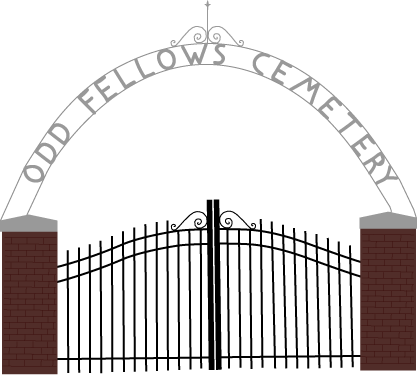LOFC and TBEC Reach Mutual Agreement
LOFC and Temple Beth El Cemetery (TBEC) have reached an agreement whereby LOFC will assume the maintenance and preservation of TBEC. In exchange, TBEC has transferred funds to be invested in the LOFC Endowment. Although TBEC appears to lie within the boundaries of LOFC, it is a separate legal conveyance. In 1902 J. H. and E. M Watson conveyed two acres of land, adjacent to the Odd Fellows Cemetery, to I. Flower, Isidore Hyman, Sam Herrman, Morris Lewis, Abe Herrman, Sol Auerbach, S. J. Fisher and H. A. Fisher as Trustees of the Hebrew Cemetery, and their successors in interest. It is this property that comprises TBEC. According to Phil Cohen, the first burial in TBEC was Carrie Sontheimer Rosenthal in 1904. Prior to this time, members of the Jewish faith had been buried in Odd Fellows Cemetery.
Carrie was one of six daughters of Jacob Sontheimer and Mary Auerbach. Although there were numerous Jewish peddlers who traveled the area selling their wares, it was Jacob Sontheimer, who was Lexington’s first permanent Jewish resident. He was also Berman’s great, great grandfather. Born in Germany in 1819, he and his family immigrated to the States when he was a young man. Originally settling in New Orleans, the family later moved north to Natchez. Like many Jewish immigrant men, Sontheimer began his career as a peddler, traveling the Mississippi territory recently opened by the Treaty of Dancing Rabbit Creek. In the mid 1850's Sontheimer opened the first store built of brick on the northeast corner of the square in the newly incorporated town of Lexington. After years of operation, the Sontheimer mercanile store became one of the largest retail businesses in the state.
Other Jewish families followed Sontheimer to Holmes County, many of whom became merchants and opened stores on the Lexington square and later were buried in TBEC. Family names in addition to Sontheimer are: Flowers, Schur, Cohen, Kaplan, Stern, Hyman, Herrman, Lewis, Paris, Berman, Rosenthal, Flower, Flink, Applebaum, Fisher and Jacobson. By the 1930’s, the Jewish community in Lexington at its pinnacle totaled 89. Most were merchants, but there were also food brokers, bankers, wholesale grocers, retail grocers, tailors, salesmen, farmers and a plantation owner, as well as a lawyer, insurance agent, cattle trader, oil man, theater owner, scrap metal dealer, manufacturer, baker and butcher. As Parham Williams once wrote, “I have often thought that Lexington’s Jewish community lifted that little town from the commonplace to an enviable level of culture and business entrepreneurship.
PO Box 1213
Lexington, MS 39095-1213
8:00 a.m. to 5:00 p.m.
Daylight Savings Time:
8:00 a.m. to 7:00 p.m.
Any unauthorized entry after closing is prohibited.
Copyright © 2026 Lexington Odd Fellows Cemetery, Inc.

